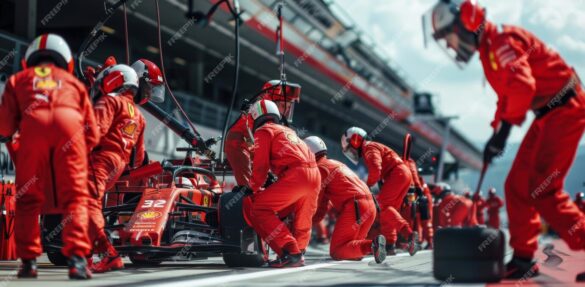In Formula 1, a race is won by more than just a driver’s skill or a car’s performance. It’s the seamless collaboration between the driver, the pit crew, and the coaching team that turns milliseconds into victories. The pit crew, often referred to as the unsung heroes of F1, executes crucial tasks under immense pressure. Behind their precision lies the guidance of F1 coaches who train, coordinate, and strategize to ensure every pit stop contributes to success. Let’s dive into how coaches synchronize these critical components to deliver flawless teamwork.
1. The Role of the Pit Crew in F1 Racing
The pit crew’s tasks extend far beyond tire changes. A typical pit stop can involve:
- Changing All Four Tires: Completed in under three seconds, a pit stop is an art of speed and synchronization.
- Wing Adjustments: Minor changes to the front wing can improve aerodynamics during the race.
- Repairs: In cases of damage, quick fixes ensure the car remains competitive.
Each crew member has a specialized role, from operating the jack to handling the wheel gun, and even a slight delay can cost a race. Coaches ensure every team member knows their role inside out.
2. The Coach’s Role in Pit Crew Training
F1 coaches are responsible for turning a group of skilled technicians into a well-oiled machine. Training is intense, precise, and tailored to prepare the crew for real-world challenges. Key areas of focus include:
- Perfecting Timing and Coordination: Coaches drill the crew through repetitive exercises, ensuring that each task is performed in sync. The goal is to achieve muscle memory so that every movement is instinctive.
- Physical Conditioning: Pit crew members train to build strength and endurance, enabling them to handle heavy tools and maintain peak performance during long races.
- Simulating High-Stress Scenarios: Coaches create realistic simulations of race-day conditions, including unexpected events like faulty equipment or miscommunication. This prepares the crew to remain calm and execute under pressure.
- Analyzing Performance: Video analysis is a key tool for coaches. By reviewing footage of pit stops, they identify inefficiencies and refine techniques to shave off precious milliseconds.
3. The Synergy Between Driver and Pit Crew
A successful pit stop isn’t just about the crew’s execution—it requires seamless communication between the driver and the team. Coaches play a critical role in fostering this synergy by:
- Training Drivers to Communicate Clearly: Drivers need to convey issues like tire degradation or car damage concisely to the team.
- Preparing for Unexpected Scenarios: Coaches rehearse strategies for dealing with last-minute changes, such as switching to wet tires during sudden rain.
- Building Trust: A driver must have full confidence in the crew to perform efficiently, and coaches work to establish this trust through consistent preparation.
4. Real-Time Decision-Making: The Coach’s Strategic Role
During a race, F1 coaches are integral to the pit wall, where real-time data and split-second decisions determine pit strategies. Their responsibilities include:
- Timing Pit Stops: Coaches analyze telemetry data to decide the optimal moment for a pit stop, balancing tire wear, track conditions, and competitor strategies.
- Adapting to Race Dynamics: Unpredictable factors like safety cars, crashes, or weather changes require coaches to adjust strategies on the fly.
- Coordinating with Engineers: Coaches work closely with race engineers to ensure that car adjustments during a pit stop align with overall strategy.
This level of coordination ensures that every pit stop is not just a mechanical task but a tactical advantage.
5. Legendary Pit Stop Moments in F1 History
Some of the most memorable races in F1 history were defined by flawless pit crew execution and strategic coaching:
- Red Bull Racing’s Record-Breaking Stops: Red Bull holds the record for the fastest pit stop in F1 history, changing all four tires in just 1.82 seconds during the 2019 Brazilian Grand Prix. This level of precision is a testament to their rigorous training and teamwork.
- Michael Schumacher’s 1998 Hungarian GP Victory: Ferrari’s strategic call for an additional pit stop allowed Schumacher to run lighter and faster, ultimately securing victory. The pit crew’s swift execution was crucial to this strategy’s success.
- Lewis Hamilton’s Tire Gamble at Silverstone 2020: When Hamilton’s tire failed on the final lap, Mercedes’ quick decision-making and pit crew efficiency earlier in the race ensured he had enough of a lead to cross the finish line on three wheels.
6. The Human Factor: Building Team Chemistry
While technology plays a significant role in modern F1, the human element remains irreplaceable. Coaches focus on building team chemistry by:
- Fostering Communication: Open dialogue between crew members ensures that every voice is heard and potential issues are addressed.
- Encouraging Accountability: Each crew member takes pride in their role, knowing that their contribution impacts the team’s success.
- Celebrating Success: Recognizing achievements, both big and small, keeps morale high and motivates the crew to strive for excellence.

